A sea of stone - biodiversity and history
Bella S. Galil
National Institute of Oceanography
POB 8030, Haifa 31080,
Israel
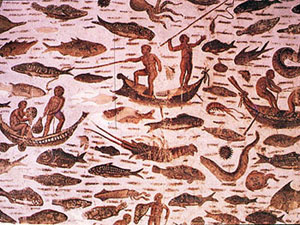 |
Note fishing methods (rod and line, trap,
drag net, sling net) and fish so ably depicted as to allow
scientific identification.
Ancient mosaics of fish and fishing methods in the Mediterranean Sea
illustrate Aristotle, Pliny and Oppian.
|
"Infinite and beyond ken are the tribes that
move and swim in the depths of the sea, and none could name them
certainly; for no man hath reached the limit of the sea, but unto three
hundred fathoms less or more men know and have explored the deep". |
With these words, Oppian gives us the ancient world view of the sea.
A native of Cilicia, present-day Gulf of Iskendrun, Oppian lived during
the latter half of the second century CE and is the author of
Halieutica, a five-volume poem on fish and fishing. In 3,500 lines of
verse he classifies and characterizes the fish, fishing seasons, and
ancient fishing methods in the waters of the Mediterranean Sea.
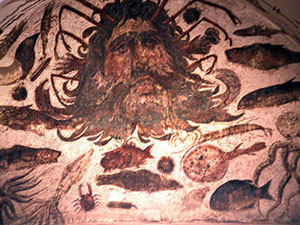 |
Head of Oceanus crowned with lobster legs and surrounded by
torpedo, rockfish, moray eel, squid, sea urchin, crab, octopus and
panaeid shrimp.
Oppian was not the first to describe the Mediterranean and its fish.
The earliest surviving record of the region's marine life appears in a
5th century BCE collection of essays entitled Corpus Hippocraticum.
The anonymous author classifies edible fish according to the quality of
their flesh and their habitat: rock fish, migratory fish, fish living on
the seabed, predators, and plant eaters. In the 4th century BCE, the
Greek philosopher Aristotle laid the foundations of zoology in his
ten-volume work on animal life, Historia animalium. Scholars of
marine life relied on his work for the next two millennia. Pliny the
Elder, devoted a volume of his Historiae Naturalis to sea
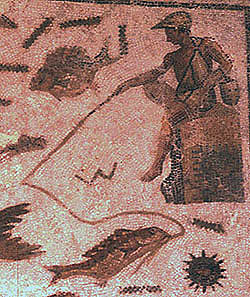 |
A fisherman sits on a rock by the seaside.
creatures, naming 74 species of fish. Romans considered marine fish
superior to freshwater fish and prices reflected their preference: Pliny
the Elder grumbled about the extravagance of his generation, and
complained that a high quality fish might cost as much as three cooks.
Not surprisingly, the fish preferred in antiquity are today's favorites
too: sea bass, grouper, striped sea bream, mullet and meager, as well as
oysters, squid, shrimp, and sea urchins.
In the 1st century BCE oysters and fish were raised commercially
around the Bay of Naples: six thousand moray eels were dispatched for a
victory feast of Julius Caesar. Affluent Romans boasted ponds stocked
with rare imported fish, which they treated as pets. Emperor Claudius'
mother is said to have hung gold rings in the nostrils of her favorite
moray eel. Mosaic floors from Africa Proconsularis (present day Algeria,
Tunisia and Libya) depict ponds teeming with fish - probably a
provincial effort to emulate the fashions of Rome. One marine mosaic
discovered in Achola in Tunisia is so accurate as to allow scientific
identification of the fish.
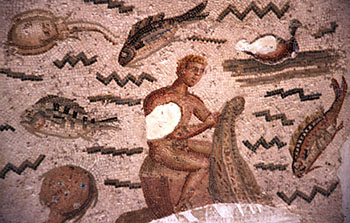 |
Fisherman mending a net.
Mosaic floors in the ruins of splendid villas portray the fishing
methods of the ancient world as if they were illustrations commissioned
for Oppians' four methods of fishing: rod and line, harpoon, trap and
net. In one mosaic, a fisherman sits on a rock by the seaside, wearing a
broad-brimmed straw hat and a short cloak to protect himself from the
burning sun or the morning chill; a basket of bait hangs from his waist.
He casts his line into the sea, crosses his legs, and tries his luck
with the philosophical patience that has characterized fishermen
throughout the ages. Another mosaic shows a fisherman, his muscles
bulging from the effort of pushing his barque through the surf. In the
shallows beside the boat is another fisherman about to cast his sling
net, a circular net with weights fastened around its edge. The fisherman
has folded the net onto his right arm, ready for action, and he lies in
wait for the fish passing by in the shallow water. When a shoal
approaches, he casts his net and the weights spread it to its full
extent; as it lands on the seabed, it traps the fish beneath.
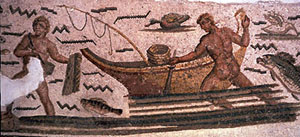 |
A fisherman pushes his barque through the
surf. In the shallow another fisherman is about to cast his sling
net.
In another section of the same mosaic, a fisherman impales an octopus
hidden under a rock with a trident, and since the octopus may put a
valiant fight, the fisherman has a large club with which to stun his
catch. Pliny and Oppian both relate how fishermen locate the hiding
place of an octopus by the empty shells strewn roundabout. Two fishermen
sit in a small boat depicted in another mosaic. One plies the oars while
the other pulls on wickerwork traps. Traps like these were used to catch
lobsters and octopuses; they were placed in the sea in the evening and
raised at dawn - a fisherman in another boat shows off his prize - a
large lobster.
These ancient mosaics of marine life do not pretend to show the
natural habitat of the fish. Neither were they produced solely as works
of art. Due to their reproductive capacity, fish were considered sacred
fertility symbols by the people residing along the shores of the
Mediterranean. The various illustrations of sea creatures at the moment
they are raised on a hook or trapped in a net, are a celebration of the
abundance and fecundity of the sea.
|
